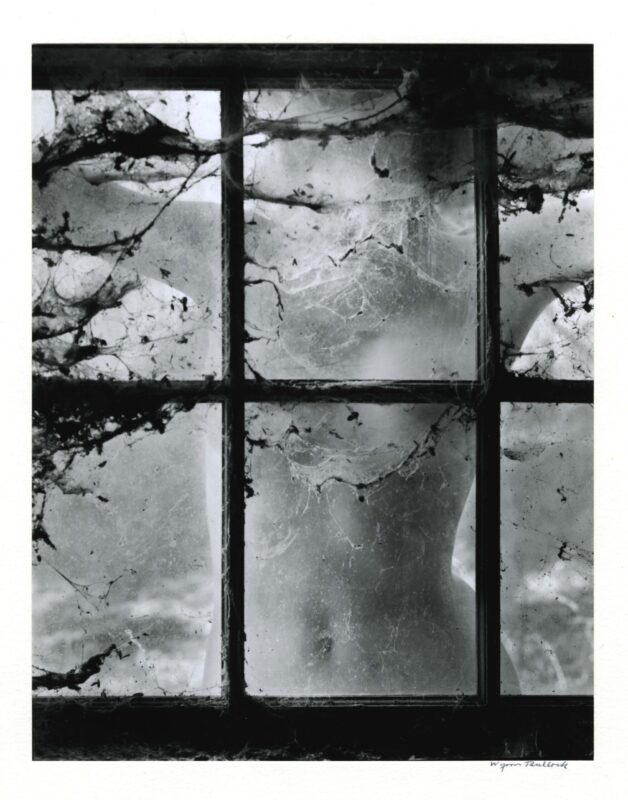California Stories

English Label
Wynn Bullock, United States, 1902-1975
Nude Behind Cobwebbed Window, 1955 (printed 1970s)
Gelatin silver print
“When Wynn Bullock asked this young nude model to go into the abandoned structure…she said, ‘I’ll stay outside and you go in.’ And that’s what he did. It turned out to be a truly serendipitous decision. By shooting from the inside looking out – the opposite of what he’d originally intended – he saw her body bathed in an ethereal glow that added a transcendent quality to the image.” – Paul Cotter, September 2018, Wynn Bullock Photography website
“In 1938 Bullock enrolled at the Los Angeles Art Center School. Three years later, his work was showcased in one of the Los Angeles County Museum of Art’s early solo photography exhibitions. During the 1940s, he conducted pioneering research to control the effect of solarization (a darkroom process for altering an image) and was awarded patents in the U.S., Canada, and Great Britain for a “Photographic Process for Producing Line Image.
Bullock was deeply inspired by fellow photographer Edward Weston, whom he met in 1948. Weston’s work motivated him to investigate straight photography. Throughout the 1950s, Bullock clarified his unique point of view, establishing a deep, direct connection with nature. A lifelong learner, he also read widely in the areas of physics, general semantics, philosophy, psychology, Eastern religion, and art.
Along with Ansel Adams, Harry Callahan, Aaron Siskind, and Frederick Sommer, he was one of the founding photographers whose archives established the Center for Creative Photography in 1975.” – Center for Creative Photography, University of Arizona
Spanish Label
Wynn Bullock, Estados Unidos, 1902-1975
Nude Behind Cobwebbed Window [Desnudo detrás de una ventana de telarañas], 1955 (impreso en los 1970)
Impreso en gelatina de plata
“Cuando Wynn Bullock le preguntó a su joven modelo de desnudos que fuera hacia la estructura abandonada …ella dijo, ‘Yo me quedaré afuera y tú entras’. Y eso es lo que hizo. Resultó ser una decisión verdaderamente fortuita. Al fotografiar desde el interior hacia afuera – lo opuesto a lo que el había originalmente planeado – vio su cuerpo bañado en un brillo etéreo que añadió una calidad trascendente a la imagen”. – Paul Cotter, September 2018, sitio web de Wynn Bullock Photography
“En 1938 Bullock se inscribió en Los Angeles Art Center School [Escuela del Centro de Arte de Los Ángeles]. Tres años más tarde, su obra fue exhibida en uno de las exhibiciones fotográficas individuales en Los Ángeles County Museum of Art [Museo de Arte del Condado de Los Ángeles]. Durante los 1940, condujo una investigación pionera para controlar el efecto de la solarización (un proceso del cuarto oscuro para alterar una imagen) y se le concedió patentes en los Estados Unidos, Canadá y Gran Bretaña para un “Proceso fotográfico para producir imagen en línea.”
Bullock fue profundamente inspirado por su compañero fotógrafo Edward Weston a quien conoció en 1948. La obra de Weston lo motivó a investigar la fotografía directa. A lo largo de los 1950, Bullock aclaró su punto de vista único, estableciendo un conexión profunda y directa con la naturaleza. Un aprendiz permanente, también leyó extensamente en las áreas de física, semántica general, filosofía, psicología, religión oriental y arte.
Junto a Ansel Adams, Harry Callahan, Aaron Siskind y Frederick Sommer, fue uno de los fotógrafos fundadores cuyos archivos establecieron el Center for Creative Photography [Centro para la Fotografía Creativa] en 1975.” – Center for Creative Photography [Centro para la Fotografía Creativa], Universidad de Arizona

